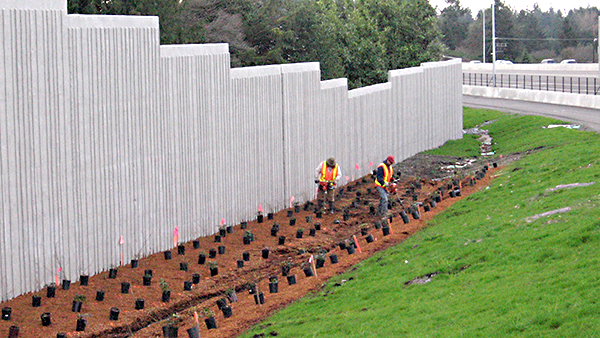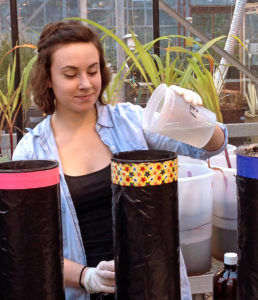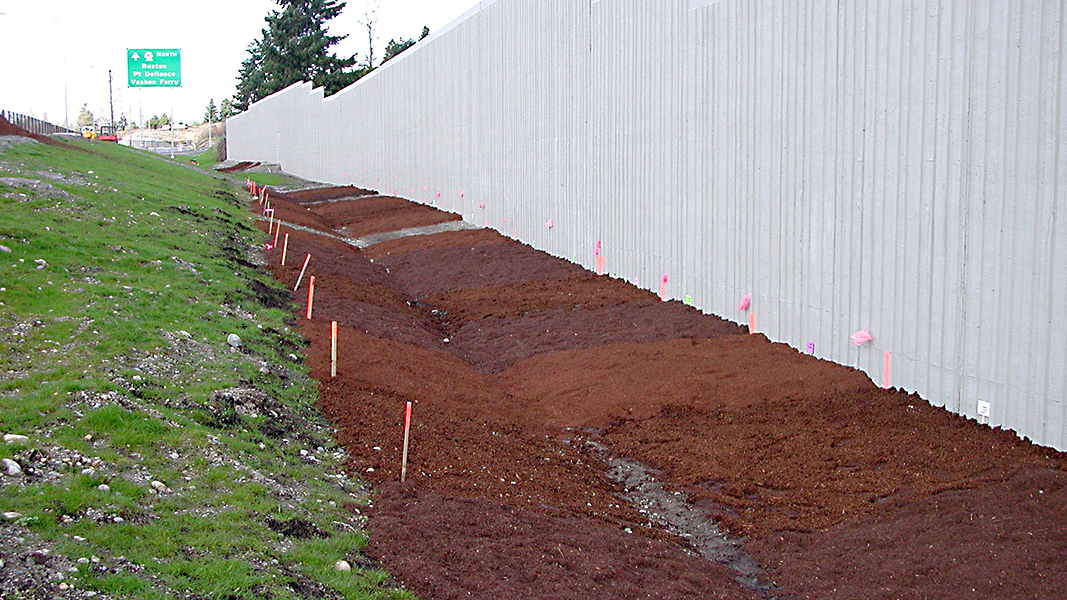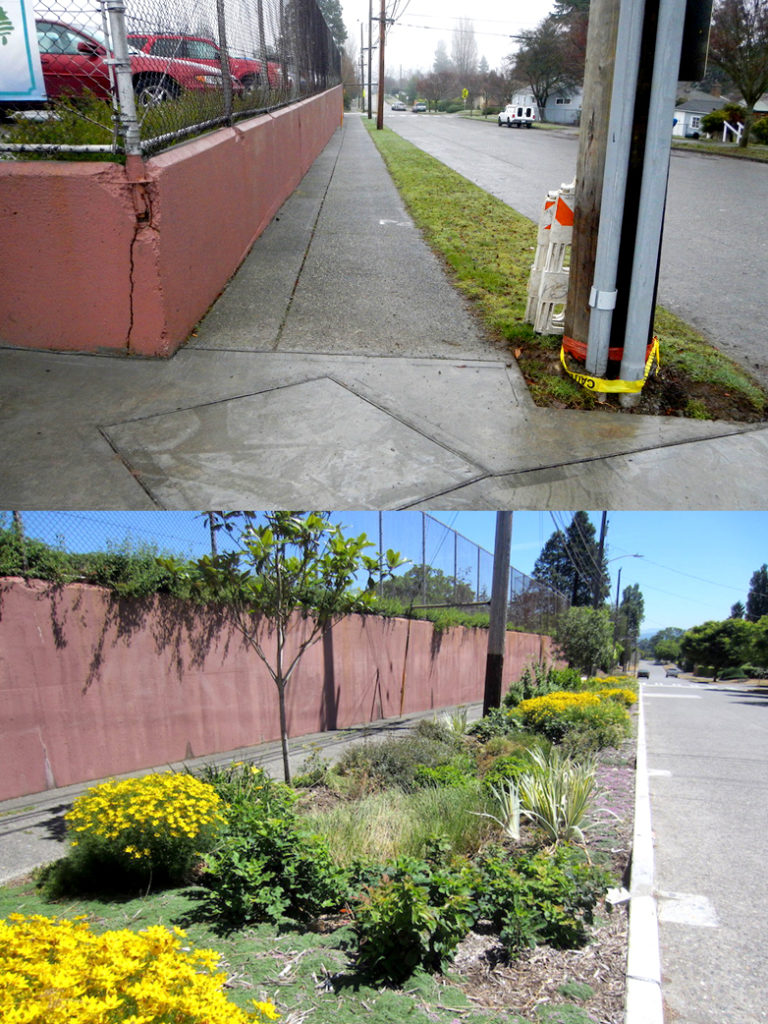
Sally Brown
Two of the most common types of storm water systems for roadways are vegetative swales and biofiltration strips. Both rely on the quality of soils or manufactured soil mixes to work. Both are also relatively inexpensive to construct and maintain. Both would benefit from compost.

Construction of vegetative swale in Washington State (top photo and above). Photos courtesy of Craig Cogger, Washington State University
Vegetative Swales
All highways — excluding those in the core of downtowns — have dirt on the side of the road. Here is the scoop on that dirt. It is generally very poor stuff, dug up and piled and compacted in the process of building that road. It is not something highway engineers would ever think about or research in their design manual. However, if you add compost to it, in sufficient amounts, it can cut the need and associated costs for all of the engineered water systems to a small fraction of what has been estimated.
Bad dirt is almost the same as more impervious surface. Water will soak in so slowly to compacted soil that it functions the same way as asphalt. The difference between this type of dirt and asphalt is that asphalt doesn’t erode. If you hit compacted subsoil with rain in sufficient volumes or with sufficient force (think thunderstorm) you will end up with an asphalt surface full of dirt to clean up, in addition to any flooding problems.

Megan Tyler-Plog pours collected storm water into a biofiltration strip soil mixture at University of Washington lab to measure nutrient and metals removal.
Craig Cogger and Andy Bary from Washington State University amended some of this dirt on the side of a highway outside of Tacoma. It was subsoil that had been placed there as part of new road construction (see vegetative swale photos). The engineers in charge had made sure the dirt was smooth and even. In other words, it was very highly compacted. The bulk density measured 2.2 g cm3 with pure rock coming in at 2.65 g cm3 and a healthy soil at less than 1.2 g cm3. Composts were added either on the top or gently incorporated (as much as possible without breaking the equipment) at a rate of 100 to 150 tons/hectare.
Incorporation worked better than laying the layer on top of the compacted dirt. It reduced the bulk density to 0.9-1 g cm3. The amended soil held onto that added carbon at a rate of 0.35-0.47 tons of C/ton of amendment applied. If you want to express that as CO2 that comes to 1.28- 1.72 tons/ton applied. That is an excellent return on the compost.
The infiltration rate wasn’t measured but you can look at other sites to get an idea of what you’d expect. At nearby community gardens we incorporated compost and bulk density decreased from 1.1 g cm3 to 0.6 g cm3. Water infiltration rates increased from a very respectable 24 inches/hour to up to 500 inches/hour. If adding compost to a right of way soil takes you from 0 to 24, that is a very respectable acceleration rate. Add some more compost and you might make it from zero to 500, with no possibility of getting a ticket. You can learn how to calculate water infiltration in a January 2020 Connections Column.
What worked here will work for any vegetated swale. If you take this information when you construct vegetative swales, you will also get marked improvements in performance that will likely improve over time.
Biofiltration Strips
We’ve tested a range of composts and biosolids as components of bioretention storm water systems. For this application, we mixed different organics with sand. Bioretention systems are increasingly used in cities, installed off of streets and parking lots. They are the same concept as biofiltration strips used for highway runoff. For one study, we tested different mixtures using storm water collected from a big highway in Seattle. Pure sand was used as a control. The storm water sped through the sand at a rate of 47 inches/hour. With most of the compost blends we upped that acceleration to 71, clocking in at over 300 inches/hour for one mix. A few of the composts slowed the water down, but with a tune up they would be up to speed.
All of the mixtures reduced the turbidity (read particulates) in comparison to the sand alone. Turbidity, a measure of relative clarity of a liquid, in the sand alone was 88 NTUs (Nephelometric Turbidity Unit). Values with compost ranged from 6.5 to 32 NTUs. We also found generally good contaminant removal. It was excellent for metals and polyaromatic hydrocarbons (PAHs) with poor results for nutrients. However, this study and previous work has shown that nutrient export goes down over time and with the inclusion of plants. If you try to starve the system of nutrients at start up, you end up with dead plants and a system that looks more like an eyesore than an enhancement.
There is a big trend for many of these systems to move away from locally available composts to proprietary mixtures. These can include special ingredients such as coconut fiber and iron filings. This adds to the cost, the carbon footprint, and it isn’t clear how much it helps. Using composts, in particular locally available materials, for these systems is a way to reduce both costs and carbon.
Direct Application On Right Of Ways
Storm water control is just one way highways can make use of composts. There is no reason that compost can’t be applied to the right of ways on all highways on an annual basis. This would improve plant growth, reduce potential for erosion, and increase infiltration. Extensive research has been done showing how effective compost is for erosion control on roadsides and construction sites. Put that material in a sock or a blanket to get even more bang for your buck. Take erosion control and storm water mitigation and add in a few native flowers and you could even make being stuck in traffic a more pleasant experience.
Using conservative assumptions, we recently modeled the potential for carbon sequestration when using biosolids-based composts along highway right of ways. Factoring in transport, the fertilizer value of the material and a conservative value for soil carbon storage, we ended up with sequestration of 1.2 tons of CO2 for each ton of compost applied. That is an excellent return on application. Plus, it makes the highways prettier and is much cheaper than any of the engineered solutions. Next up in Part III — how much compost do Departments of Transportation use and how much could they use?
Sally Brown, BioCycle’s Senior Adviser and long-time Connections columnist, is a Research Professor at the College of the Environment at the University of Washington.











